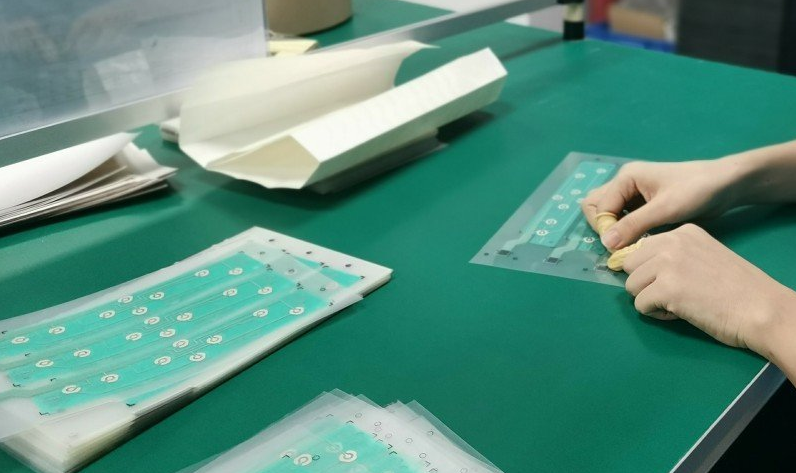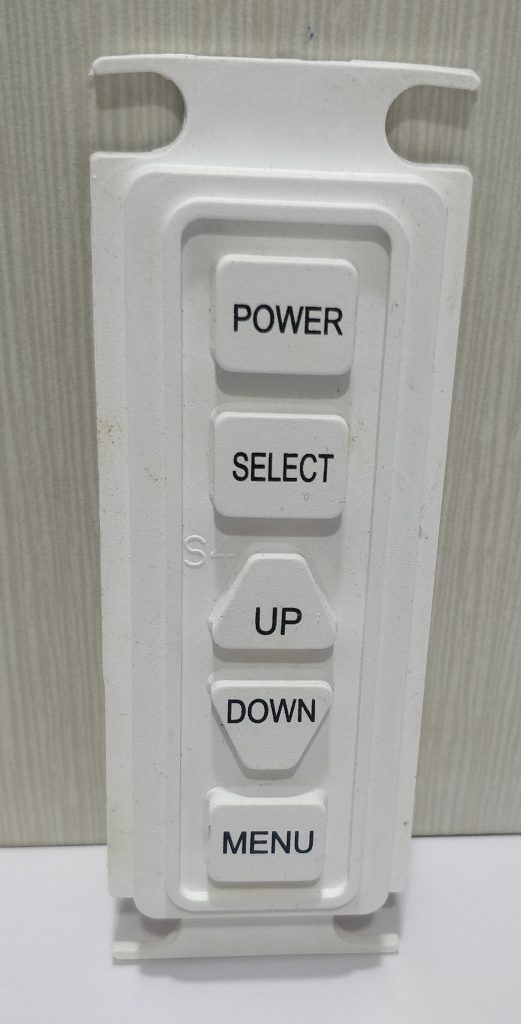
Tactile VS Non-Tactile Products
Numerous products can be made with a tactile or non-tactile feature. Some particular products can be made in two different ways, while others can be made just a single way or the other. Products, for example, membrane switches can be made utilizing either tactile or non-tactile feedback system. Capacitive touch, Resistive touch, and Force Sensing resistors (FSR) are examples of products that must be made with a non-tactile feature. While every item enjoys its own benefits, ensure they line up with precisely what your gadget needs to do.
How do Tactile switches function?
Tactile feedback implies that there is an improved feeling of touch or touch is perceived in much better way by the user as compared to non-tactile feedback. This further implies that the button can be pushed down, and the user can feel it pop back up. Tactile switches are likewise designed to act momentarily, which means the switch possibly works when the button is being pushed or pressed. When the push or press action is discontinued, the button activity is stopped. This sort of switch just works for that particular moment of action.
One thing to add to establish tactile feedback is metal domes. To read more about the significance of metal domes in membrane keypads, click here. The domes are set between the graphic overlay and the bottom circuit. At the point when a membrane switch is planned to be designed with a tactile feedback feature, there should be a dome holding layer to prevent the domes from moving uninhibitedly. The click that is heard from a metal dome being pushed or pressed permits the user to realize that the button was indeed pressed effectively so as to complete the continuity in the circuit.
An incredible feature of utilizing metal domes is that they can be pressed more than 1,000,000 times without wearing out. Actuator pads can be put on the topmost point of the metal domes to build the tactile feel. There are numerous sorts of metal domes. A few domes as of now contain an actuator that gives an extra raised piece of the metal dome, making it more tactile in nature. An actuator or pad arrangement can build the tactile feel in case the domes height is excessively low in contrast with the membrane keypad. Sometimes it happens that the client is worried that an ordinary level top metal dome probably won’t be just about as connective as they need, in that case, we can arrange domes with dimples. This sort of metal dome assists with making the connectivity between the circuit and the button in more effective manner.
Polydome switches are commonly used. Polydomes are characterized by embossed domes in the plastic material that make the tactile feel successful with the metal dome. “Poly” comes from the polymer (polyester) utilized for the membrane switch.

The benefit of utilizing Polydome switches over customary metal dome switches is that there is no metal engaged with the Polydome switch. In case the switch is utilized around any fluid, polydomes are generally the favored choice in light of the fact that the materials would remain undeterred unlike the metal. In worst case scenario, if the metal dome experiences dampness, it could stain and short out the circuit. The Polydome switches can give a similar tactile feel without all the risk. It is matter of the fact, the tactile feel got from polydome switches is as realistic as membrane switches with metal domes.
Silicone Rubber Keypads
Silicone Rubber keypads are exceptionally tactile by nature. But when it comes to Silicone Keypads there is necessity of physical movement that should be made to make continuity between the button and the circuit. A significant benefit of silicone keypads is that they are produced using molded silicone. The keypads can be customized to meet needs of the customer.

We at Linepro Controls are experts in Customized Input Devices and likewise, we can deliver any design as per customer’s wish. Stack up of a typical silicone keypad is simple. Silicone is molded to make tall buttons. Within the silicone contains a carbon pill that is utilized to make the continuity possible between the button being pushed and the Printed Circuit Board (PCB). The carbon pill hits traces of silver conductive ink to respond to the button movement all through the PCB. Something extraordinary with regards to silicone keypads is that they are entirely durable and sturdy. They are best suitable in harsh working conditions, for example, safety and construction since they keep going for longer span and can be utilized outdoors or indoors effectively.
Albeit the keypads are tactile, Linepro Controls can add non-tactile functionality too, for example, LED lights to improve upon the client’s experience. Silicone is a normally dead fronting material to entirely diffuse the light into the right spots of keypad.
How do Non-Tactile switches work?

A non-tactile switch has no mechanical movement between the button and the circuit. Linepro Controls has developed keypads that can deliver no sound and no reaction click. These keypads utilize two silver traces with a spacer film in the middle. Somewhat similar in functionality to a metal dome, the film is utilized to isolate the silver from being in continuity. The drawback of non-tactile switches is that the absence of feedback feel (as in case of tactile feedback devices) may be a concern to the user. Haptic feedback assumes an enormous part in non-tactile membrane switches. Lights that glow when input is made by user are a good choice that can be conceivable with the utilization of these switches. The circuitry can contain lights that furnish the user with a reaction to realize that the machine is being worked appropriately.
The Non-tactile Capacitive Touch Switch
Capacitive touch sensors are non-tactile products. They utilize an electric charge held inside a silver circuit layer. At the point when a finger comes in extremely closeness with the circuit layer, the capacitance of the circuit is changed, and the signal is passed on to the controller that the “button” has been pressed.

At the point when an individual presses a capacitive touch sensor, they can’t feel any movement inside the gadget. Capacitive touch Keypads are predominantly used for domestic devices like Television, Air Conditioners, washing machines and drying machines. Capacitive touch sensors don’t have any moving parts. This implies that they are amazingly durable and simple to clean. The sensors can be incorporated into curved in-mold electronic gadget surfaces that induce more creative design.
Capacitive touch sensors need to depend on haptic feedback to permit a tactile reaction with the goal that the client can have feedback. Haptic feedback normally incorporates to stimulating the feeling of touch. This is predominant in game controllers like Xbox or Sony Playstation. This should likewise be possible by utilizing sounds or lights to give right feedback. LEDs can be integrated into a PCB that has a dial on the front. The other sort of haptic feedback is the utilization of sound. An alert sound can be customized to activate when the capacitive touch sensor can detect that the user is there.
Force Sensing Resistor as a Tactile Switch
Force Sensing resistors (FSR) are just non-tactile. Haptic is significant for getting feedback from the FSR. Normally, the feedback is shown utilizing LEDs that light up the gradient filled bar to show the pressure applied. Utilizing a Force Sensing resistor (FSR) as a button has many benefits.

There are two sorts of FSR: shunt mode and thru mode. The decision of utilizing either of two types of FSR depends on the fact the magnitude of force you need to detect. For example, the shunt mode FSR can be used in case where wide ranges of force are into play. And when it comes to Thru mode FSR they are capable of mapping sensitive and lighter magnitude forces. At the point when numerous FSR’s are situated on a similar gadget, it is known as a Matrix FSR. Matrix FSR’s are famous in light of the fact that they can gauge forces over a broader region. One example of Matrix FSR is they are used as unique shoe inserts to decide how a sprinter’s feet hit the ground and map the forces accordingly, to study upon the running action of the sprinter, so as to improvise upon his actions. FSR’s can likewise be utilized in robotics as well. In contrast to humans, robots can’t see how much pressure they are applying without FSR embedded on them. Another medical application utilizes a matrix FSR in hospital beds to identify if the patient is available on bed or not. It is a widespread feature to ensure patients are in their beds, and if by any chance they drop out, an alarm caution is made to the trained clinical staff.
There are a couple of layers that make up a FSR. The primary layer is a stretchable TPU film. Silver is then imprinted onto that film in a Busbar framework. A layer of carbon is then added over the silver. Finally, a cover film is put on top to ensure the newly assembled FSR.
Advantages of Tactile and Non Tactile Switches over Traditional Mechanical Switches

We all have witnessed how technology, over a decade’s time, has ceased to evolve as something more compact, slimmer and thinner. And it is matter of fact that Keypads and Keyboards are not an exception to this change too. If at all, we recollect using the computer keyboards some 10 years back, those keyboard buttons were very much bulky, heighted and possessed significant tactile feel which was difficult for manufacturers to eliminate. Take a look at your laptop keyboard, and you will find the user experience the best ever. In the same manner, the membrane keypads have evolved to be as thin as card board paper. Mechanical switches are always vulnerable to dust and fluid spill. But, in case of Membrane Keypads, they are resistant to dust, fluids, heat an UV radiation. This means they can be used effectively indoors where the membrane switches are exposed to harsh conditions as well as outdoors.
If you have any queries related to tactile and non-tactile gadgets, Contact Us today! Linepro Controls is an expert manufacturer in Customized Input Devices for any industry.

